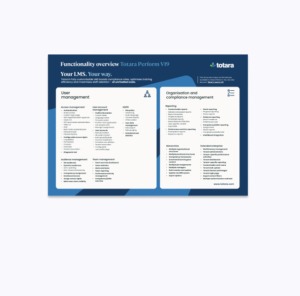What’s the first thing you think about when writing an employee performance review?
Chances are, you dread delivering the pending performance review or have questions like:
- “What should I write in an employee performance review?”
- “How do you write a performance review for a bad employee?”
- “What points should an employee performance review include?”
Lots of managers go so far as to avoid giving employee feedback altogether, especially when it’s negative. It’s human nature, we don’t want to make others feel bad, so we avoid those difficult conversations and instead sweep issues under the rug.
If this all sounds familiar, it’s time to change your ways.
In this post, you’ll learn everything you need to know to quickly write an effective employee performance review that’s useful to your employees and your organization.

Specific points to write about in an employee performance review
Every organization (and its employees) will require different areas of focus when it’s time to document and review employee performance.
This is where employee performance management software like Totara Perform shines, as you can connect performance to employee development, build competency frameworks, request feedback from other employees and assign hierarchies for roles in your organization—all from one central system.
Even if you don’t have a performance management tool to streamline the review writing process, there are key points any employee performance review should cover to be truly effective and inspire positive change:
- Analysis of the employee’s job description: Reviewing a team member’s job description will provide context as to what their current core skill sets and behaviors are, and what they should look like moving forward.If you work closely with a team member, this is a great starting point for developing an understanding of their strengths, weaknesses and areas of improvement.
- Mitigation of bias with 360-degree feedback (or any feedback) from colleagues: 360-degree feedback is a performance management tool (sometimes called a 360 performance review) that asks multiple people to provide feedback on an employee’s performance for a more comprehensive and fair insight into an employee’s performance.This might include their direct manager, teammates, colleagues outside the team and even clients or other third parties.
- Assessing strengths and weaknesses: Including the previous two discussion points will make it easier to identify strengths and areas of improvement to inform actionable employee performance goals and next steps for every employee.
Recommended read: Managing organizational structure (positions & hierarchies) in Totara Learn and Totara Perform
How to write an employee performance review
Now that we’ve listed the essential points you should cover in your employee performance review, here are the guidelines on how to deliver them.
1. Be direct when delivering negative feedback
If you need to give negative feedback, it can be tempting to tiptoe around it. But your employees know when you’re avoiding an issue, and they will appreciate you being direct. This means addressing the matter upfront and not stalling for time.
92% of employees agree that negative feedback, when delivered appropriately, is effective at improving performance, so there’s no need to worry about raising constructive criticism.
An easy approach is simply to make it the first thing you speak about.
Starting the conversation with “I wanted to talk about x” or “John gave me some feedback on project y that I’d like to share with you” means that you can go straight into the conversation.
Otherwise, you risk building unnecessary anxiety for your employee, who may be wondering what’s coming.
2. Be tactful with your tone
Think about the difference between these two phrases:
“Kira told me that she noticed a few mistakes in your last report. I know this is unusual for you, so I was hoping you could give me some context around that?”
“I was extremely disappointed to hear from another manager that your last report was completely wrong. This is obviously unacceptable, and I won’t tolerate this again.”
We’ve all heard the phrase “It’s not what you say, but how you say it,” and that is never more true than when you’re delivering feedback to an employee.
As a manager, you have the power to set the tone of the conversation, and you’re responsible for not making a mountain out of a molehill and equally, not downplaying a serious problem.
Looking at the conversation openers above, you will see that while the content is the same, the tone is completely different. The first is non-confrontational, concerned and factual.
The second is likely to make your employee feel anxious and worried and doesn’t give them a chance to explain themselves.
When delivering any feedback, ensure that your tone is not accusatory, aggressive or confrontational, and give your employee the opportunity to provide context or set the record straight (the right performance management system will help you with this). This leads to our next tip…
3. Encourage a two-way dialogue
No employee wants to listen to a torrent of feedback without having the opportunity to respond, so it’s vital that managers and employees alike get to have their say.
As a manager, you may need to raise some difficult topics. However, it’s essential that you then invite your employee to share their thoughts about the situation.
If you bring up a performance issue, it is likely that your employee can offer a unique insight, whether that’s external issues, personal problems or some hidden context.
The more you can support a two-way dialogue, the more productive your conversations will be. Your employees will respect your reasonable approach to perceived performance issues, and you will benefit from greater openness and honesty.
4. Give positive feedback
Four out of 10 employees are actively disengaged when they get little feedback, so taking the time to recognize achievements and accomplishments is vital to maintain a high level of engagement across your organization.
As much as employees like to hear positive feedback, managers can often find it surprisingly difficult to raise, especially when they’re not used to it.
A good way to deliver positive feedback is to start small, with casual comments in the moment, such as “Nice work on project X!” or “That was your best presentation yet!”. You can then build up to more structured positive feedback in your performance conversations.
The best practice with feedback is to ensure that it’s specific so as not to sound disingenuous. There’s a stark contrast between saying:
- “You’re so good with people!”
- “I wanted to commend you on your excellent phone manner—in fact your customer feedback shows that your customers really appreciate your calm, efficient approach to problem-solving.”
5. Keep track of performance conversations
Virtually everyone has experienced coming into an annual appraisal, only to have absolutely nothing from the previous year’s conversation discussed (this is why we suggest implementing a continuous performance management approach).
If you were asked to work on your organizational skills, for instance, it’s highly likely that both you and your manager will have forgotten this by the time your next appraisal comes around, making these performance conversations a little redundant.
Of course, if this becomes a pattern, it erodes everyone’s trust in the performance management process. Whether positive or negative, managers should ensure that they record all feedback in their performance management system.
This could be informal, in-the-moment comments, quick discussions as part of a monthly check-in or even comments from coworkers on the employee’s performance. This makes your life much easier when it’s time for annual appraisals—you can then look back on a whole bank of feedback and information about your employee’s performance.
Systematically recording feedback in your performance management system also empowers you to identify trends early.
For instance, perhaps you asked your employee to improve their product knowledge. You can track your conversations over the year to see whether or not the employee is demonstrating better knowledge, or whether you need to intervene.
An integrated performance management system, such as Totara Perform, sits alongside your learning management system to allow you to link useful learning and resources to performance records, driving engagement and ensuring that employees know exactly where they stand and how to improve their performance at any point throughout the year.






